Are you a Quiet Speculation member?
If not, now is a perfect time to join up! Our powerful tools, breaking-news analysis, and exclusive Discord channel will make sure you stay up to date and ahead of the curve.
Assumptions and collectively-held beliefs are fickle and powerful things. They can affect perception and, in a way, become reality if unchallenged. Therefore, it is critical for the skeptical mind to evaluate and investigate these ideas for validity, especially in the wake of recent bannings. After being challenged on long-held beliefs about Splinter Twin's effect on Modern, I've decided to investigate them. Did Twin in fact regulate Modern successfully? My research has only made me more skeptical.
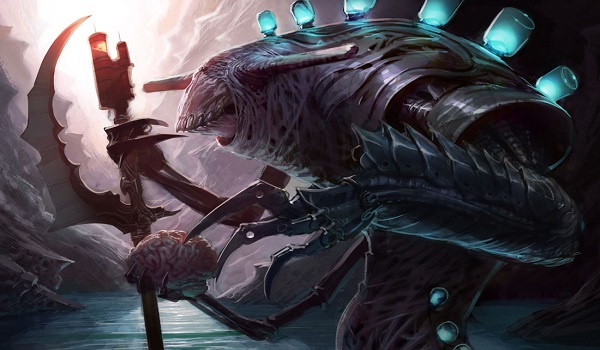
Initial Assumption
Twin's reputation as of January 2016 was one of format policeman. When the unexpected banning happened, many players panicked. We'd never lived in a Twinless format before, and the fear was that Modern would explode with fast linear decks. We all knew that Twin forced decks to play interaction to not die to the consistent combo on turn 4, so absent that pressure, why bother interacting? And yet, Wizards killed the deck for winning too much. Fair enough: Twin did seem to win everything. Despite this, Modern players continue to pine for Twin's return to reign in more linear decks.
The Question
However, would Twin even do that? I was explaining the many calls for Twin's unbanning to some newer players a few months ago, and one of them commented that Twin just seemed busted. Another asked why one deck mandating interaction was seen as acceptable instead of format-warping, a common 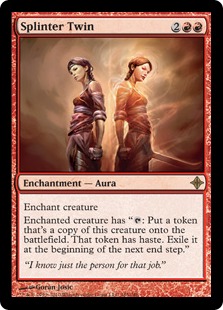 argument against unbanning Twin. All were dubious that forcing interaction slowed decks down, and wondered if decks wouldn't just try and race Twin. My answer was that racing wasn't really an option, as Infect was the only deck that could, and doing so still proved a a long shot (especially given Twin's available tools at the time).
argument against unbanning Twin. All were dubious that forcing interaction slowed decks down, and wondered if decks wouldn't just try and race Twin. My answer was that racing wasn't really an option, as Infect was the only deck that could, and doing so still proved a a long shot (especially given Twin's available tools at the time).
This conversation reminded me of how many cards in the linear/fast decks that get complained about didn't exist back in Twin's day. The power cards in Humans (Thalia's Lieutenant, Kitesail Freebooter, etc.), Cathartic Reunion, Arclight Phoenix, Spell Queller, Hollow One, Scrap Trawler, Search for Azcanta, and many others have all only existed in a Twinless world. Could Twin regulate them? For that matter, did Twin actually need to keep these kinds of decks out of Modern? Is there evidence of Twin regulating the format?
Year-by-Year Analysis
The logical place to start is by diving into the available data. Fortunately, MTGTop8 has been keeping stats for the Modern metagame forever, so I pulled their yearly data for the four full years that Twin was legal in Modern. I then collected data from top-performing unfair linear decks from the time of the Twin ban, some perfectly fair decks, and Birthing Pod. Note that Amulet Titan didn't have any reported metagame presence in 2012 and that Pod was banned in 2015.
Also, I'm aggregating all the Twin decks and all the GBx decks together in their respective mega-archetypes. This is mostly because my source grouped all Twin decks under the same banner, and frequently mixes Abzan and four-color lists in with straight Jund, but also to make the graph's I'm using less crowded.
| Deck Name | 2012 | 2013 | 2014 | 2015 |
|---|---|---|---|---|
| URx Twin | 6 | 8 | 10 | 11 |
| Pod | 9 | 11 | 11 | - |
| Amulet Bloom | - | 1 | 2 | 5 |
| Infect | 3 | 2 | 2 | 4 |
| GR Tron | 7 | 10 | 6 | 6 |
| Affinity | 11 | 7 | 9 | 9 |
| GBx | 15 | 15 | 8 | 13 |
| UWx Midrange | 5 | 7 | 5 | 3 |
Amulet and Infect enjoyed high points in their metagame shares while Twin was also at its peak. The other decks in the sample were below their peaks, but were relatively stable. Meanwhile, Twin had been rising prior to Pod's ban, and didn't affect Pod's share. In fact, only UWx declined between 2014 and 2015.
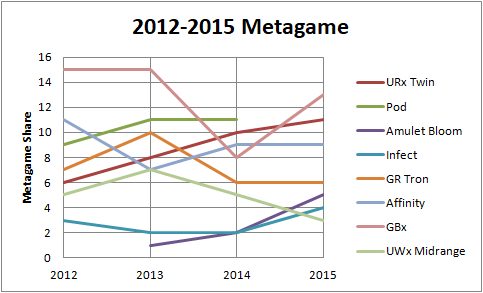
No Evidence Yet
The fact that Amulet Bloom and Infect increased their metagame share during Twin's 2014-2015 joyride pokes a hole in the Twin-as-regulator narrative. Twin had a pretty good matchup against both decks, so logically, they would fall off as Twin ascended. However, this is also a very zoomed-out view of things, and there are very few data points. Confounding variables and other metagame considerations could have affected the results, so I continued my investigation with a deeper dive.
Monthly Data Dive
Fortunately for me, 2015 was the year that Modern Nexus got started. Thus, I went back and gathered the Metagame Breakdowns for that year (oh, for Wizards to release that kind of data again) and pulled the decks that were available from my original investigation.
| Deck Name | 2/16-3/16 | 3/1-4/1 | 4/1-5/1 | 5/1-6/1 | 6/1-7/1 | 7/1-8/1 | 8/1-8/31 | 9/1-9/30 | 10/1-10/31 | 11/1-11/30 | 12/1-12/31 |
|---|---|---|---|---|---|---|---|---|---|---|---|
| URx Twin | 12.3 | 11.8 | 11.8 | 11.3 | 12.5 | 12.5 | 9.5 | 7.5 | 10.2 | 11.1 | 12.5 |
| Infect | 7 | 6 | 4.5 | 3.6 | 3.5 | 3.4 | 4.1 | 4.5 | 5.3 | 4 | 3.7 |
| GR Tron | 2.9 | 3 | 3.1 | 3.8 | 5.3 | 4.2 | 3.5 | 5.1 | 5.5 | 6.2 | 6.9 |
| Affinity | 7.8 | 7 | 7.1 | 5.8 | 8.5 | 8.4 | 6.9 | 11 | 9.3 | 8.6 | 8.3 |
| GBx | 13.4 | 17.4 | 13.1 | 14.5 | 12.4 | 12.4 | 10.3 | 12.9 | 12.5 | 11.6 | 11,8 |
| Amulet Bloom | 2.7 | 2.7 | 2.9 | 3.2 | 4.1 | 3.4 | 1.7 | 3.7 | 4.1 | 5.2 | 4.2 |
Every deck shows volatility in the sample. Twin and Affinity finished the year meaninglessly higher than they started; Infect is very down; both Tron and Amulet Bloom are well above their starting positions. Again, this doesn't fit with the narrative about Twin. Also again, this isn't definitive.
I don't have enough individual data points for valid statistical analysis, so instead I have to rely on judging the observable trends in the data. However, this isn't arbitrary guesswork or Magic Eye interpretation. Specifically, if the belief that Twin regulated unfair or linear decks is true, then I should see a predator-prey relationship in the data. This would look like offset lines; in other words, the peak of the predator's line should match the midpoint of the decline of the prey's line, and vice-versa. This would clearly demonstrate that policing effect Twin was said to have.
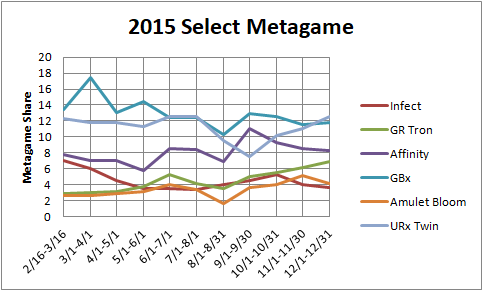
This graph certainly doesn't look like the classic graph. There doesn't appear to be any real pattern in the data except for the dip every non-Infect deck in August and September, from which they all rebound. This was the period when Grixis Control was suddenly, though only briefly, a thing, but I can't be 100% certain this or any single deck or event were the cause. Again, this isn't helping Twin's case, but the graph is also busy enough that I separated the results to look for that predator-prey graph.
Deck by Deck
First up is Infect. Twin was favored, and as a result, Infect was considered a metagame call for when Twin was out of favor. Thus, I expected to see see Infect ascending where Twin was low.
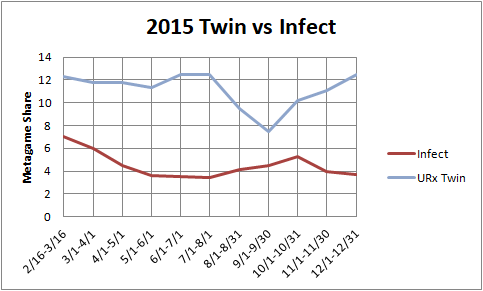
There may be evidence in Twin's favor here. Infect is overall on a downward trend while Twin was effectively a flat line for February-May. Between May and July they both flatlined, then for the rest of the summer, Twin was in the summer slump while Infect was up. Once that was over and Twin rose again, there was a delayed decline for Infect, which is consistent with predator-prey. However, this was only demonstrated for part of the year, so I'm calling the relationship present, but weak.
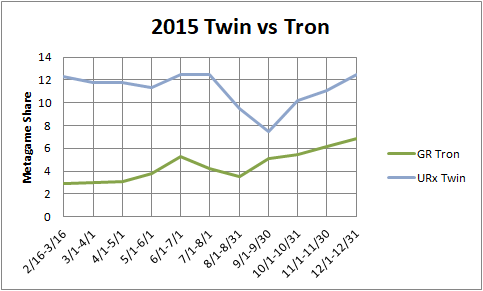
For Twin vs Tron, there really isn't predator-prey type correlation. They're almost symmetrical and parallel lines. Tron is on an overall upward trend for 2015, but has a local peak the same time as Twin does in June. Tron recovers from the slump first and then follows Twin in recovery, ending well above its previous metagame share. This is more a lockstep kind of correlation, so this data doesn't support Twin policing Tron.
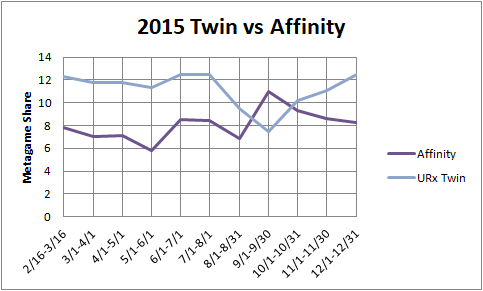
Affinity is very interesting. Up until August, Affinity and Twin are practically parallel, rising and falling at the same time (though not to the same degree). Afterwards, Affinity achieves its local peak at the same time as Twin's local trough. For the rest of the year, Affinity declines while Twin rises. This is consistent with both predator-prey and the metagaming cycle. Given that it's not true for about half the year, I'm saying on net it's weak evidence for Twin policing it.
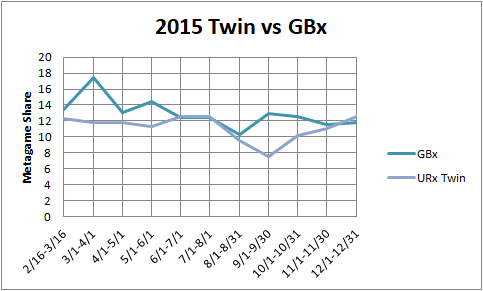
Twin vs GBx and Jund in particular was generally seen as an even matchup. Jund could beat the Twin combo with Abrupt Decay and there was little Twin could do, so it turned into an attrition game. Their metagame percentages seem to reflect this analysis; Jund shows a lot of early volatility, while Twin is almost perfectly stable. They both feel the late-summer droop, but GBx recovers first, and they end the year equal. I don't think this provides any evidence in Twin's favor. Even if it does, it's very weak.
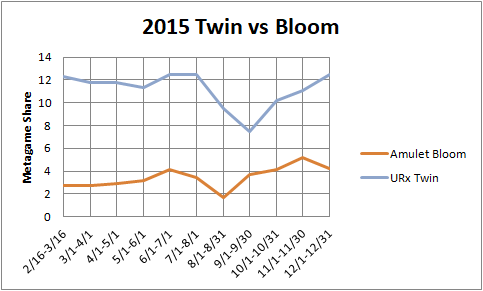
Twin was known to have a good Bloom matchup from Bloom's coming out party. The data does show signs of predator-prey, with Twin falling and recovering after Bloom. The early months see Bloom slowly rising, which is odd since Twin is fairly stable. Twin may have policed this deck.
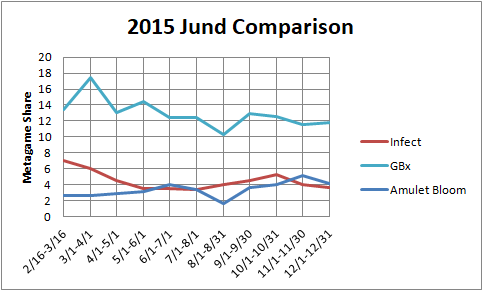
Out of curiosity and as a comparison, I compared GBx to Infect and Amulet Bloom. I was surprised to see similarly weak predator-prey correlation. It makes sense that GBx would prey on Infect thanks to the discard and spot removal. However, midrange decks generally struggle against big mana, and Bloom had plenty of ways to get around discard. I'm not sure what to make of this.
Coincidental at Best
My monthly-data dive showed several possible instances of Twin preying on decks, as the model predicts. One was quite a solid example, while the others are questionable. This is 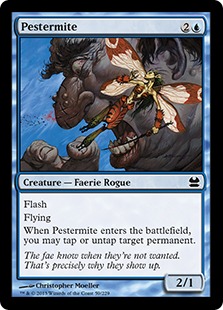 complicated by there being a general decline in non-Infect decks in late summer, which may simply be a coincidence. The drop is integral to the predator-prey relationship being observably real, but again, I can't confirm that this wasn't some outside distortion making it look correct.
complicated by there being a general decline in non-Infect decks in late summer, which may simply be a coincidence. The drop is integral to the predator-prey relationship being observably real, but again, I can't confirm that this wasn't some outside distortion making it look correct.
The overall picture indicates that Twin was not keeping Infect, Affinity, Tron, or Amulet Bloom down, as each gained metagame share while Twin was at its peak. The more detailed look suggests that Twin preying on these decks is at least plausible. This is neither evidence for or against the hypothesis that Twin regulated Modern, complicating a firm conclusion.
Beyond Twin in 2016
The other option is to look at the consequences of the Twin banning. In the aftermath, it was assumed that linear decks would dominate. Then Oath of the Gatewatch happened, and Modern went down the tubes for several months. This makes evaluating 2016, the year most free from the printings that supercharged a lot of linear decks in 2017, difficult. Once again, I'm using our metagame breakdown data from 2016, which is a bit fragmented since the January and March data was ruined and mooted by bannings with October and November lost to logistical problems.
| Deck Name | 2/5-3/6 | 4/8-5/1 | 5/1-5/31 | 6/1-6/30 | 7/1-7/31 | 8/1-8/31 | 9/1-9/30 | 12/1-12/31 |
|---|---|---|---|---|---|---|---|---|
| Eldrazi | 34.9 | 1.6 | 2.8 | 2.8 | 4.5 | 6.3 | 9.2 | 4.3 |
| Infect | 3.8 | 5.6 | 6.3 | 8.5 | 5.7 | 5.9 | 7.6 | 10.2 |
| GR Tron | 2.1 | 3.6 | 7.6 | 5.4 | 3.8 | 3.1 | 3.5 | 3.8 |
| GBx | 4 | 12.8 | 10.9 | 11.6 | 12 | 13.7 | 10.5 | 11.2 |
| Affinity | 8.9 | 5.8 | 4.7 | 5.7 | 6.2 | 6.5 | 7.5 | 5.3 |
Remember how bad Eldrazi Winter was? I didn't, until I started pulling up the data. I know there are those that believe that Twin would have kept Eldrazi in check for the same reasons it allegedly kept other decks down. While it is theoretically possible, the fact that Colorless Eldrazi dominated the No Banned List Modern Open makes that claim suspect. Maybe Eldrazi Winter wouldn't have been as bad, but I seriously doubt that Twin could have stood up to the spaghetti monsters.
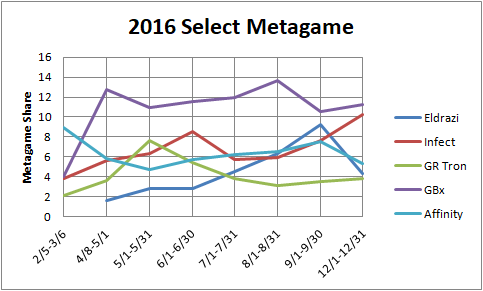
Infect clearly ends the year as the highest performing stand-alone deck. This would suggest that once free of Twin and Eldrazi, it was the best deck in Modern, which supports the Twin-as-moderator argument. However, Affinity started the year strong having lost a bad matchup, then failed to maintain its position and fell quite a bit, which is contrary to the expectations. Tron also ends higher than it started, but on the same level as it was post-Eldrazi Winter. Jund recovered from its beating and did quite well, while Eldrazi turned into Bant Eldrazi and had a good September before falling off.
There's no real pattern to the data indicating that losing Twin unleashed a swath of linear decks. It is also worth remembering that the spike in Infect late in the year coincided with Blossoming Defense's printing.
Claims Unproven
After considering all the data I gathered, I cannot definitively say that Twin did in fact keep any linear deck in check. Since my assumption was that Twin  was a policing agent, the ambiguity of the data is the more important result. If Twin was having a direct effect on the existing unfair decks by forcing them to interact, slowing down their kills, and therefore making them worse, I can't see it in the data.
was a policing agent, the ambiguity of the data is the more important result. If Twin was having a direct effect on the existing unfair decks by forcing them to interact, slowing down their kills, and therefore making them worse, I can't see it in the data.
Whether Twin was keeping out otherwise viable non-interactive decks is similarly impossible to say. However, I doubt it. There wasn't a huge burst of diversity post-Eye of Ugin ban, and the metagame looked pretty similar to pre-Twin ban Modern. A lot of critical cards for the current linear decks were printed after January 2016. The only deck that could have existed then and didn't is Grixis Death's Shadow, but as that deck developed from Traverse Shadow, I doubt it would have. This leaves the pro-Twin claim on shakey ground.
Specific Examples
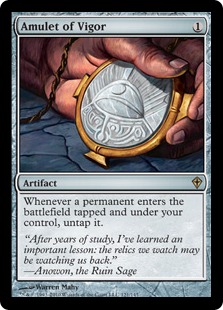 Since the overall data doesn't clearly answer the question, I've also looked at how specific decks reacted to the banning. This has only served to further weaken the case for Twin's police powers.
Since the overall data doesn't clearly answer the question, I've also looked at how specific decks reacted to the banning. This has only served to further weaken the case for Twin's police powers.
First, consider Amulet Bloom, arguably the poster child for broken linear decks. As demonstrated at the Pro Tour, the deck was insanely powerful and capable of winning on turn 2. However, it had an appallingly bad Twin matchup, to the point that Justin Cohen didn't consider it winnable by anything other than luck. Despite this and how well Twin did in 2015, Amulet still increased its metagame share over the year. That's impressive, especially considering how intimidating the deck was to pick up.
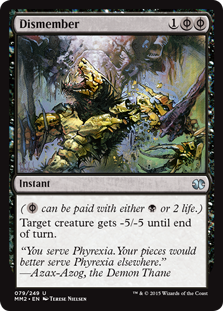 The second, and I think more damning, study was to compare Twin-era linears to their post-Twin counterparts. If they had removed interaction in favor of faster kills, there might be something to the notion of Twin forcing interaction.
The second, and I think more damning, study was to compare Twin-era linears to their post-Twin counterparts. If they had removed interaction in favor of faster kills, there might be something to the notion of Twin forcing interaction.
However, I didn't find that proof. Infect decks from the end of Twin era are virtually identical to decks from the eve of Gitaxian Probe's banning: no more or less interaction between the maindeck and sideboard. Spellskite and Wild Defiance got bumped from the maindeck to the sideboard to make room for Blossoming Defense, while the overall number of counters and Dismembers remained the same.
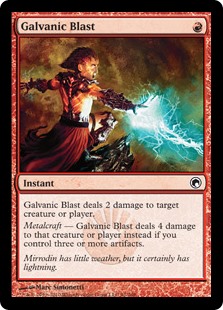 Perhaps the most devastating evidence against Twin's supposed policeman effect is Affinity. The latest traditional Affinity deck (as of writing) is virtually unchanged from the Affinity decks of 2015. Even Galvanic Blast is still a mainboard four-of, while a few counters or Thoughtseize remain in the sideboard. I'm not seeing proof that Twin forced interaction as much as proof that decks that want some interaction play some, regardless of the metagame.
Perhaps the most devastating evidence against Twin's supposed policeman effect is Affinity. The latest traditional Affinity deck (as of writing) is virtually unchanged from the Affinity decks of 2015. Even Galvanic Blast is still a mainboard four-of, while a few counters or Thoughtseize remain in the sideboard. I'm not seeing proof that Twin forced interaction as much as proof that decks that want some interaction play some, regardless of the metagame.
Perception Becomes Reality
If Twin had no provable tangible effect on the viability of linear decks in Modern, why was that such a widespread belief? I suspect and will argue conventional wisdom. It makes perfect sense that Twin would have such an effect. It was a consistent turn four kill that had to be respected at all times. That was the speed limit, and there really weren't decks that consistently beat Twin in a footrace. It made logical sense for it to be true, and with everyone repeating the line for years, it became accepted as truth.
In this scenario, Twin was a format regulator through perception. The belief that a deck that would just lose to turn four Twin being unviable served as the format's gatekeeper. In other words, the conventional wisdom of Twin's effect produced a psychological barrier that had the effect of making the effect true, regardless of what was factually true.
Unbanning Complications
If the truth of Twin's regulatory powers were primarily psychological in the first place, it seems unlikely that it could be so again. Decks now have the means and likely the willingness to challenge Twin when this arguably wasn't true previously. Given how Modern's changed since January 2016, I believe such a challenge would be successful. Many of the linear decks that Twin's champions claim will be regulated were not viable in 2015 because the cards that made them decks didn't exist. Given the speed of decks like Hollow One, I have serious doubts that Twin would effectively regulate them.
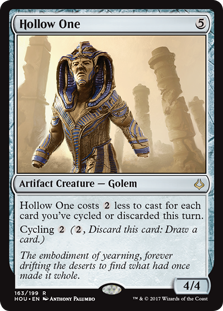 The only certain impact of unbanning Splinter Twin would be the unleashing of a combo-control deck. This deck is capable of winning on turn four in a way that requires players to leave mana open or simply die. How healthy or desirable is this effect?
The only certain impact of unbanning Splinter Twin would be the unleashing of a combo-control deck. This deck is capable of winning on turn four in a way that requires players to leave mana open or simply die. How healthy or desirable is this effect?
Finally, there's the diversity question. Back in Twin's day, the card pool was smaller, so fewer decks were viable. However, this was also a time when the best decks held 10% or more of the metagame year after year. In 2017 and 2018, only Death's Shadow was that high, a statistic that did not persist. Twin, Pod, and Affinity were at the top of the metagame every year from Modern's inception until relevant bannings took place. 2017 and 2018 saw huge shakeups in the top tiers. Whether the actual strategic diversity has changed is unclear, but it is clear that there is no longer a presumptive best deck year after year, and that increases competitive diversity.
My Bottom Line
I suspect that if Twin is unbanned and is still good (which is unknowable), it would draw in significant metagame share. After all, why play any other deck? Why play Arclight Phoenix or Storm when Twin is a more reliable combo than storm and can incorporate most of Phoenix's tools? Would Twin just coopt Thing in the Ice to easily outclass anything in its colors?
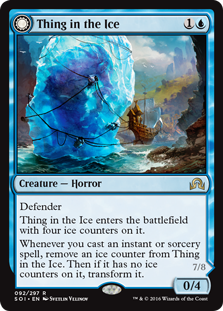 Twin also resists hate. There was no sideboard card or deck that knocked Twin off its perch prior to the ban, and if Twin is still good I have no reason to think one would today. Torpor Orb, Suppression Field, and Ghostly Prison were all effective against the combo, but weren't enough then, and there's nothing better now. Fatal Push requires a revolt trigger to kill Exarch or Pestermite. Twin can also play into this, because it's extremely hard to be prepared for both the combo and control plans; if there's going to be hate, just sideboard around it and still win.
Twin also resists hate. There was no sideboard card or deck that knocked Twin off its perch prior to the ban, and if Twin is still good I have no reason to think one would today. Torpor Orb, Suppression Field, and Ghostly Prison were all effective against the combo, but weren't enough then, and there's nothing better now. Fatal Push requires a revolt trigger to kill Exarch or Pestermite. Twin can also play into this, because it's extremely hard to be prepared for both the combo and control plans; if there's going to be hate, just sideboard around it and still win.
Right now, there are good reasons to pick any deck and to switch off decks as the metagame shifts. Is that something worth risking?
Murky Waters
I cannot say definitively if Twin actually policed Modern because I cannot prove it with data. Thus, I cannot extrapolate whether it would do so now. Absence of evidence is not evidence of absence, but the fact that data did not support the policing claim strongly suggests the claim is untrue. The only effect that I can say unbanning Twin would have is to return that turn-four combo deck to Modern. Given that there are serious concerns about the gameplay the deck encourages, I don't think it's something Modern needs. Krark-Clan Ironworks being banned for similar gameplay demands makes a Twin unban look even more remote.
If Twin doesn't actually police Modern, but is just another busted combo deck that sucks up everyone else's metagame share, is it worth having? If it does police Modern, is the way it does so good for format health and player enjoyment? The thought I can't shake after this data dive: quis custodiet ipsos custodes?




It would be interesting to see how twin could affect lower tier decks.
If twin was unbanned I’d fear that it would nuke away all lower tier that can appear sometimes in various tournaments.
The reduction of diversity shouldn’t be intended only for URx deck, but also considering lower tier that many players who want twin unban hate, maybe because they cause the “lottery feeling” of Modern. Lottery match-up that I know has been proven false.
That is possible, though very hard to say. It appears that Twin was simply sitting atop Modern rather actively pushing anything out. This suggests that the lower tiers would be relatively unaffected by the unban compared to the upper ones.
My expectation is if you’re running a low tier or completely rogue deck then it’s a passion project that you’d stick with regardless of the metagame. Upper tier players are more likely to be interested in winning and be willing to switch decks as a result. Thus if it’s the random noise that is drawing player hatred no banning or unbanning will fix it.
I totally agree. Twin is just too slow in many cases now with dredge and phoenix decks and lacks meaningful interaction with all the vial and cavern decks running around
Who contends that twin regulated the format? I was into modern before it was an official format, so I’ve had front row seats to the format.
UR Twin policed players’ creativity and incentive to explore <10 years of cardpool more than anything, which threatens to be a problem whenever there’s one deck that rewards mastery too well.
Every banlist announcement you see that argument trotted out. I think most people believed it at the time of the ban. Having actually examined the data I’m pretty sure you’re right, it was simply the best deck and did what any best deck did. Now that there isn’t a presumptive best deck year after year, there’s a lot more room for creativity.
and here i thought that i was the last sane person on the internet regarding the ‘policing nonsense’, well done David for a great article
it’s always the same nonsense people say when they don’t want their deck to get banned and invent fictional reasons about why the world will fall apart if it does:
‘don’t ban DRS the meta will become a graveyard infested hellhole’
‘don’t ban birthing pod, aggro will run amok without the premier aggro ‘police”
‘don’t ban Twin least nothing but linear combo remains’
the trend continues now with UR phoenix (which i do not believe should be banned), for which it’s pilots laughably claim to ‘steal points from unfair decks and give them to fair-uninteractive ones’, yeah? and how exactly does phoenix win against combo? gut shot them? it’s not that fast either, if anything creature decks like spirits and humans are the best MUs for phoenix and not fast combo decks with whom it has trouble interacting
the concept of ‘police decks’ is ridiculous and needs to be abolished if we’re ever to move forward in terms of magic theory
Sorry but when was Twin considered the favored matchup against Infect? Not being facetious. Honestly asking as that was an easy matchup from what I recall.
I had literally only played Infect from the days of Scars of Mirrodin until 3 weeks after the printing of Fatal Push. That was my only deck. And I LOVED the Twin match as much as the Tron match.
Spellskites (2 I believe), 4x Vines of Vastwood, 2x Dismember all in the main deck and 3x Wild Defiance out of the side plus Spell Pierce made for fun times for me! And from what I remember that was the standard deck list for everyone else at the time.
From what I remember and what my research revealed, Infect’s matchup against Twin was unfavored to even depending on what Infect ran maindeck. Numerous pros, including Todd Anderson following his SCG win with Infect, said that Infect was only the pick when Twin was at an ebb. It came down to Twin having more cantrips and thus being more likely to find its pieces than Infect. Also the counters and Blood Moon could be brutal.
Players like you with maindeck Spellskite and Wild Defiance certainly had an easier time. However, most apparently did not and Twin was adapting to Infect in the later stages of 2015 with Roast, Electrolyze, and Dispel moving to maindecks.